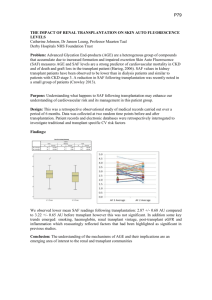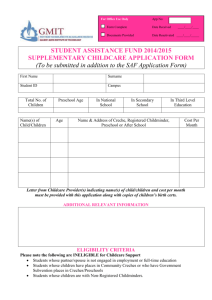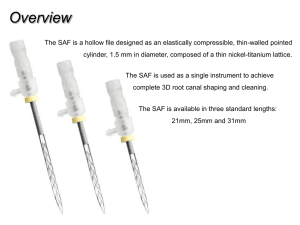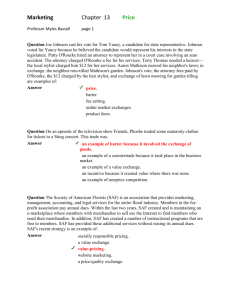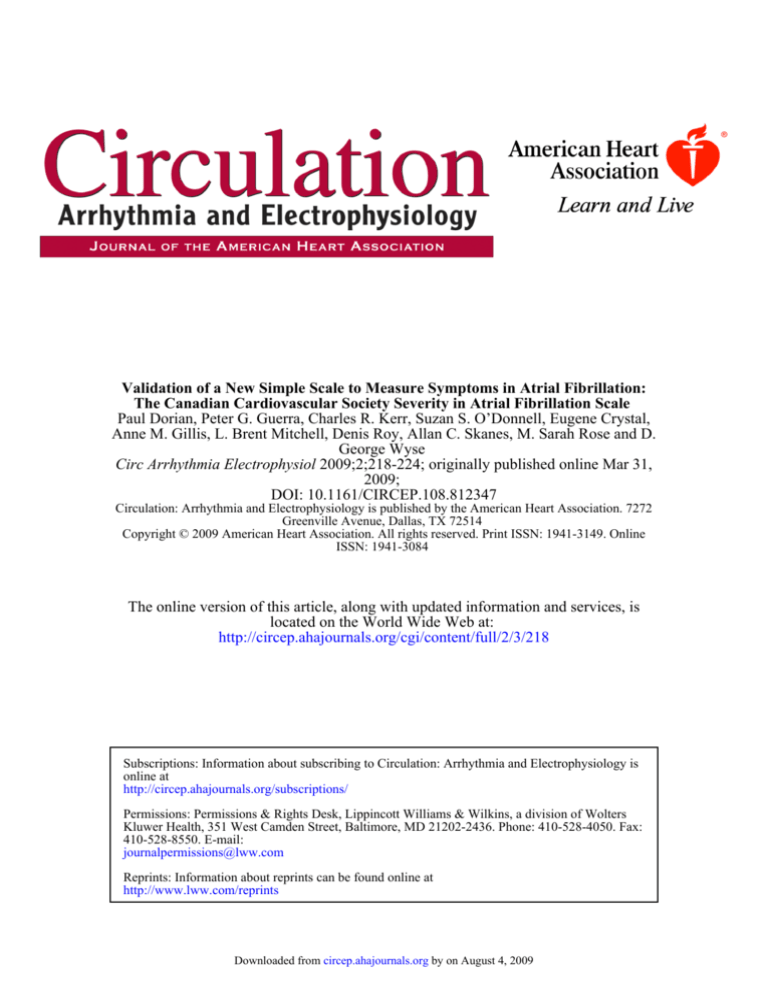
Validation of a New Simple Scale to Measure Symptoms in Atrial Fibrillation:
The Canadian Cardiovascular Society Severity in Atrial Fibrillation Scale
Paul Dorian, Peter G. Guerra, Charles R. Kerr, Suzan S. O’Donnell, Eugene Crystal,
Anne M. Gillis, L. Brent Mitchell, Denis Roy, Allan C. Skanes, M. Sarah Rose and D.
George Wyse
Circ Arrhythmia Electrophysiol 2009;2;218-224; originally published online Mar 31,
2009;
DOI: 10.1161/CIRCEP.108.812347
Circulation: Arrhythmia and Electrophysiology is published by the American Heart Association. 7272
Greenville Avenue, Dallas, TX 72514
Copyright © 2009 American Heart Association. All rights reserved. Print ISSN: 1941-3149. Online
ISSN: 1941-3084
The online version of this article, along with updated information and services, is
located on the World Wide Web at:
http://circep.ahajournals.org/cgi/content/full/2/3/218
Subscriptions: Information about subscribing to Circulation: Arrhythmia and Electrophysiology is
online at
http://circep.ahajournals.org/subscriptions/
Permissions: Permissions & Rights Desk, Lippincott Williams & Wilkins, a division of Wolters
Kluwer Health, 351 West Camden Street, Baltimore, MD 21202-2436. Phone: 410-528-4050. Fax:
410-528-8550. E-mail:
journalpermissions@lww.com
Reprints: Information about reprints can be found online at
http://www.lww.com/reprints
Downloaded from circep.ahajournals.org by on August 4, 2009
Original Articles
Validation of a New Simple Scale to Measure Symptoms in
Atrial Fibrillation
The Canadian Cardiovascular Society Severity in Atrial Fibrillation Scale
Paul Dorian, MD, MSc; Peter G. Guerra, MD; Charles R. Kerr, MD; Suzan S. O’Donnell, MSc;
Eugene Crystal, MD; Anne M. Gillis, MD; L. Brent Mitchell, MD; Denis Roy, MD;
Allan C. Skanes, MD; M. Sarah Rose, PhD; D. George Wyse, MD, PhD
Background—Atrial fibrillation (AF) is commonly associated with impaired quality of life. There is no simple validated
scale to quantify the functional illness burden of AF. The Canadian Cardiovascular Society Severity in Atrial Fibrillation
(CCS-SAF) scale is a bedside scale that ranges from class 0 to 4, from no effect on functional quality of life to a severe
effect on life quality. This study was performed to validate the scale.
Methods and Results—In 484 patients with documented AF (62.2⫾12.5 years of age, 67% men; 62% paroxysmal and 38%
persistent/permanent), the SAF class was assessed and 2 validated quality-of-life questionnaires were administered: the
SF-36 generic scale and the disease-specific AFSS (University of Toronto Atrial Fibrillation Severity Scale). There is
a significant linear graded correlation between the SAF class and measures of symptom severity, physical and emotional
components of quality of life, general well-being, and health care consumption related to AF. Patients with SAF class
0 had age- and sex-standardized SF-36 scores of 0.15⫾0.16 and ⫺0.04⫾0.31 (SD units), that is, units away from the
mean population score for the mental and physical summary scores, respectively. For each unit increase in SAF class,
there is a 0.36 and 0.40 SD unit decrease in the SF-36 score for the physical and mental components. As the SAF class
increases from 0 to 4, the symptom severity score (range, 0 to 35) increases from 4.2⫾5.0 to 18.4⫾7.8 (P⬍0.0001).
Conclusions—The CCS-SAF scale is a simple semiquantitative scale that closely approximates patient-reported subjective
measures of quality of life in AF and may be practical for clinical use. (Circ Arrhythmia Electrophysiol. 2009;2:218-224.)
Key Words: atrial fibrillation 䡲 quality of life
A
trial fibrillation (AF) is common and impairs quality of
life (QOL) as much as some severe chronic illnesses.1–3
Because AF is rarely life-threatening, making management
decisions and gauging response to treatment is most often
made on the basis of expected or observed improvement in
symptoms and QOL.4 –5 Measuring QOL is usually done with
questionnaires, which are impractical for routine clinical use
because they require ample time for completion and complex
statistical analyses, and result in multiple scores that can be
difficult to interpret. A simple “bedside” composite measure
of symptoms and their effects on QOL in individual patients
would be useful and would help standardize the language
used to describe the severity of the clinical syndrome in
individual patients.6
Editorial see p 213
Clinical Perspective on p 224
Assessing symptoms in AF can be challenging in that
variables such as whether the arrhythmia is paroxysmal or
persistent, whether the episodes are frequent or infrequent,
and the duration of episodes need to be considered. Symptom
scales that incorporate these variables can be cumbersome.
Relying on the time-tested practical use of the Canadian
Cardiovascular Society (CCS) angina class and New York
Heart Association (NYHA) congestive heart failure functional class to quantify symptoms and functional capacity, the
CCS Severity of Atrial Fibrillation (CCS-SAF) scale was
created by members of the Primary Panel of the Canadian
Cardiovascular Society Consensus Conference on Atrial Fi-
Received August 1, 2008; accepted January 14, 2009.
From the Division of Cardiology (P.D., S.S.O.), St Michael’s Hospital and the University of Toronto, Toronto, Ontario; the Division of Cardiology
(P.G.G., D.R.), Montreal Heart Institute and the Université de Montréal, Montreal, Quebec; the Division of Cardiology (C.R.K.), St Paul’s Hospital and
the University of British Columbia, Vancouver, British Columbia; the Division of Cardiology (E.C.), Sunnybrook and Women’s College Health Sciences
Centre and the University of Toronto, Toronto, Ontario; Libin Cardiovascular Institute of Alberta (A.M.G., L.B.M., D.G.W.), Department of Cardiac
Sciences, University of Calgary and Calgary Health Region, Calgary, Alberta; Alberta Heritage Foundation for Medical Research (A.M.G.); the Division
of Cardiology (A.C.S.), London Health Sciences Centre and University of Western Ontario, Calgary Health Region (M.S.R.), London, Ontario, Canada.
Michael E. Cain, MD, was Guest Editor for this article.
The online-only Data Supplement is available at http://circep.ahajournals.org/cgi/content/full/CIRCEP.108.812347/DC1.
Correspondence to Paul Dorian, MD, St Michael’s Hospital, Division of Cardiology, 30 Bond St, 6-050Q, Toronto, Ontario, M5B 1W8 Canada. E-mail
dorianp@smh.toronto.on.ca
© 2009 American Heart Association, Inc.
Circ Arrhythmia Electrophysiol is available at http://circep.ahajournals.org
218
Downloaded from circep.ahajournals.org
by on August 4, 2009
DOI: 10.1161/CIRCEP.108.812347
Dorian et al
Table 1.
Validation of the CCS-SAF Scale
219
Demographic Data
SAF Class
0 (n⫽58)
1 (n⫽135)
2 (n⫽129)
3 (n⫽126)
4 (n⫽36)
Total (n⫽484)
P Value
64.8⫾12.3
62.7⫾12.4
61.4⫾11.5
60.9⫾13.1
63.7⫾13.8
62.2⫾12.5
0.28
Sex, % men†
86.2
69.6
72.9
55.6
41.7
66.7
⬍0.001
AF pattern, % paroxysmal†
25.9
60.7
72.9
69.1
61.1
62.0
⬍0.001
Mean (IQR) AF duration, mo*
51 (12–93)
48 (10–108)
48 (18–96)
48 (26–96)
60 (36–110)
48 (18–96)
0.68
Age (mean⫾SD), y*
*P value attained by 1-way ANOVA.
†P value attained by 2 test.
brillation.5 It is a simple, concise, symptom-based severity
scale intended for routine clinical use in patients with AF.
The CCS-SAF scale (resulting in “SAF class”) provides a
potentially clinically useful scale for practitioners to assess
patient status and to communicate the severity of the functional consequences of the patient’s symptoms from AF. The
basis for development and a detailed description of this scale
has been published previously.7
The purpose of the current study was to validate the
CCS-SAF scale by using accepted measures of patientperceived severity of symptoms and impairment of QOL as
used in prior studies of AF.6,8 –11
Methods
A total of 484 English- or French-speaking patients with a history of
ECG-documented AF were recruited from Canadian cardiology
clinics in Vancouver (n⫽89), Calgary (n⫽100), London (n⫽80),
Toronto (n⫽101), or Montreal (n⫽114). All centers obtained approval from their respective research ethics boards, and each patient
provided written informed consent. At the time of clinic evaluation,
each patient’s SAF class, age, sex, predominant AF pattern (paroxysmal or persistent/permanent), duration of AF, current treatment
strategy, and current rate and rhythm control medications were
recorded. All patients subsequently completed the SF-36 generic
QOL instrument (version 1.0)12 and the disease-specific Atrial
Fibrillation Severity Scale (AFSS) instrument at the clinic visit or
within a few days.8,11
The AFSS questionnaire is a disease-specific measure of quality of
life in AF. It includes questions regarding the frequency, overall
severity, and duration of symptomatic AF episodes (given the
variable nature of symptoms in AF, the questions apply to both
paroxysmal and persistent AF); the presence and severity of individual symptoms possibly attributable to AF (such as palpitations,
dyspnea, dizziness, weakness, or chest pain [symptoms subscale]);
overall well-being (scored on a Likert scale from 0 to 10); and
cardioversion, specialist appointments, emergency room visits, and
hospitalizations in the prior year.
The SF-36 questionnaire is a generic QOL scale with minimal
overlap to the AFSS items. It assesses health-related QOL on 8
domains pertaining to physical health (4 domains) and mental health
(4 domains) and has been used extensively in health research for
Table 2.
measuring life quality.2,6,9,12 Questionnaires were scored using previously published scoring algorithms.8,12 The authors had full access
to the data and take full responsibility for its integrity. All authors
have read and agree to the manuscript as written.
The CCS-SAF Scale
The CCS-SAF scale7 is analogous to the CCS angina scale. The SAF
scale is determined by (S), symptoms attributable to AF; (A),
association between symptoms (palpitations, dyspnea, dizziness/
syncope, chest pain, weakness/fatigue) and documentation of AF or
therapies for AF (ie, therapy associated symptoms); and (F), functional consequences of these symptoms on the patient’s daily
function and quality of life. The SAF class is then rated on a scale
from 0 (asymptomatic) to 4 (severe impact of symptoms on QOL and
activities of daily living) (see Appendix in the online-only Data
Supplement).
No specific training on using the SAF scale was provided beyond
access to the original publication describing the scale design and
objectives and the description of the scale listed in the Appendix.
The number of individuals recording the SAF class was deliberately large to increase the generalizability of the SAF classification
and ranged from 1 to 6 individuals (raters) per site. These raters
consisted of electrophysiologists, electrophysiology fellows, nurse
practitioners and nurses who normally provided care in the arrhythmia clinic at each study center. A total of 17 individuals performed
the SAF class rating for this study.
Statistical Analysis
Given the large number of analyses, 2-sided probability values
⬍0.01 were considered statistically significant. Patient characteristics and questionnaire scores were described using the means and
standard deviations or by the median and interquartile range (IQR) if
the variable was highly skewed. Age and duration of AF were
compared among the SAF scale scores by 1-way ANOVA after
applying a log transformation to duration. Patient sex, AF pattern,
cause of AF, and treatment strategy were compared among SAF
scale scores using 2 and Fisher exact test. The SAF scales were
related to QOL outcomes (subscales of the SF-36 and AFSS) by
linear regression and were described using Spearman correlation
coefficient. Age- and sex-standardized scores on each scale were
obtained by subtracting the mean score of the general population for
that age group and sex and dividing by the standard deviation of the
general population13 for that age group and sex. A multivariable
AF Management Strategy
SAF Class
0 (n⫽58)
1 (n⫽135)
2 (n⫽129)
3 (n⫽126)
4 (n⫽36)
Total (n⫽484)
Rate control, %*
75.9
56.3
38.0
40.5
38.9
48.4
Rhythm control, %*
17.2
33.3
49.6
49.2
58.3
41.7
Neither strategy, %
5.2
8.2
7.0
6.4
0.0
6.4
Both strategies, %
1.7
2.2
5.4
4.0
2.8
3.5
*Rate versus rhythm control attained by test (P⬍0.001).
2
Downloaded from circep.ahajournals.org by on August 4, 2009
220
Circ Arrhythmia Electrophysiol
Table 3.
June 2009
AFSS QOL for All Patients by SAF Class
SAF Class
0 (n⫽58)
1 (n⫽135)
2 (n⫽129)
3 (n⫽126)
4 (n⫽36)
P Value
7.7⫾3.5
6.2⫾3.5
5.2⫾3.0
6.3⫾3.0
6.9⫾3.3
0.36
AF duration (range, 1–10)*†
8.4⫾3.0
6.4⫾3.3
5.9⫾2.7
6.7⫾2.6
7.1⫾2.2
0.35
AF severity (range, 1–10)*†
3.0⫾2.4
5.0⫾2.2
5.6⫾2.2
6.1⫾2.1
7.2⫾1.7
⬍0.001
Global well-being, (range 1–10)*
8.0⫾1.3
7.4⫾1.4
6.9⫾1.9
6.1⫾2.1
4.8⫾2.4
⬍0.001
Symptoms (range, 0–35)*†
4.2⫾5.0
7.7⫾6.3
10.7⫾7.2
14.1⫾6.9
18.4⫾7.8
⬍0.001
AF frequency (range, 0 –10)*†
Data are presented as mean⫾SD.
*The range of possible scores for each subscale of the AFSS is provided.
†Increasing scores indicate increasing symptoms and severity, except for global well-being, where higher scores
indicate better well-being (P values refer to the slope of the regression line).
linear regression analysis with the AFSS global well-being score as
the outcome variable was used to examine the contribution of the
SAF class to overall QOL while controlling for factors such as age,
sex, AF pattern, cause of AF, AF duration, treatment strategy, center,
and medications used (patients taking any combination of -blocker,
calcium blocker, or digoxin versus patients taking any combination
of sotalol, amiodarone, flecainide, or propafenone). Variables measuring healthcare utilization were described using the median and
IQR and were tested for differences among SAF class using the
Kruskal-Wallis test.
There was a significant positive linear relationship between
the SAF class and the AFSS severity and symptom subscales
(r⫽0.38, P⬍0.001 and r⫽0.51, P⬍0.001, respectively).
There was a ⬎4-fold increase in symptom score between SAF
class 0 and 4 and a significant negative linear relationship
between the SAF class and the AFSS global well being score
(r⫽⫺0.37, P⬍0.001). In contrast, there was no linear relation
between SAF score and (subjective) AF frequency or duration.
Results
Relationship Between the SAF Class and the SF-36
Patients were 62.2⫾12.5 years of age, 67% were male, 62%
had paroxysmal AF, and the median AF duration was 48
months (Table 1); 49% had idiopathic AF, with 30% of
patients having AF associated with hypertension, 7% with
coronary artery disease (CAD), 9% with valvular disease, and
5% with nonischemic cardiomyopathy as their primary cardiac diagnosis. There were no significant differences in
diagnosis associated with AF among the SAF class groupings. For the entire cohort, the number of patients managed
by rate control was greater than those managed by rhythm
control (48% versus 42% respectively, P⬍0.0001) (Table 2).
Patients with higher SAF class were significantly more likely
to be treated using a rhythm control than using a rate control
strategy (Table 2).
The SF-36 QOL outcome scores, for the individual subscales
and the summary mental and physical scales as grouped by
SAF class, are shown in Table 4 and Table 5.
There was a significant negative linear relationship between SAF class and each of 6 SF-36 subscales (physical
functioning, bodily pain, general health, vitality, social functioning, and mental health), and the 2 summary scales
(physical and mental health). For the individual subscales,
correlations ranged from ⫺0.24 (bodily pain) to ⫺0.42
(social functioning); all correlations were significant (all
P⬍0.001). The “role physical” and “role emotional” scales
showed a similar pattern, but correlations cannot be calculated as these are categorical scales.
SF-36 scores for each SAF class were compared with ageand sex-standardized scores for published healthy control
populations.13 The control population SAF scores in this
comparison are arbitrarily set to 0, and differences from
Relationship Between SAF Class and the AFSS
A summary of AFSS QOL outcome scores as grouped by
SAF score are shown in Table 3.
Table 4.
SF-36 QOL Subscales for All Patients
SAF Class
0 (n⫽58)
1 (n⫽135)
2 (n⫽129)
3 (n⫽126)
4 (n⫽36)
Physical Function*†
79.1⫾23.2
74.0⫾25.2
69.9⫾26.9
59.6⫾28.5
44.0⫾30.6
Role Physical*†
74.6⫾38.2
64.1⫾41.2
51.1⫾44.7
33.2⫾40.4
15.0⫾31.0
Bodily Pain*†
83.8⫾22.5
75.1⫾24.2
70.5⫾27.0
65.3⫾27.6
57.8⫾30.5
General Health*†
71.6⫾18.2
65.6⫾19.0
60.1⫾22.0
55.2⫾23.3
46.1⫾24.5
Vitality*†
66.8⫾18.7
58.5⫾21.5
51.3⫾23.3
44.0⫾22.2
30.6⫾26.3
Social Function*†
88.6⫾20.6
82.4⫾21.1
72.2⫾25.2
65.3⫾24.7
50.0⫾26.7
Role Emotional*†
88.9⫾26.2
74.4⫾36.2
67.7⫾39.6
50.9⫾44.2
34.3⫾42.5
Mental Health*†
82.8⫾11.6
76.2⫾14.1
70.5⫾18.7
67.3⫾18.9
56.8⫾25.7
Data are presented as mean⫾SD.
*The range of scores for each subscale is 0 to 100 (with higher scores indicating better quality of life).
†There is a significant inverse relation between SAF class and the SF-36 component and summary scales
(P⬍0.001).
Downloaded from circep.ahajournals.org by on August 4, 2009
Dorian et al
Table 5.
Validation of the CCS-SAF Scale
221
SF-36 QOL Component Summaries for All Patients
SAF Class
0 (n⫽58)
1 (n⫽135)
2 (n⫽129)
3 (n⫽126)
4 (n⫽36)
Physical Component Summary*†
47.8⫾10.3
46.0⫾10.3
43.6⫾11.2
39.3⫾10.9
34.2⫾10.2
Mental Component Summary*†
55.1⫾6.3
50.7⫾8.8
47.7⫾10.5
44.6⫾10.5
38.8⫾13.9
Data are presented as mean⫾SD.
*The range of scores for each subscale is 0 to 100 (with higher scores indicating better quality of life).
†There is a significant inverse relation between SAF class and the SF-36 component and summary scales
(P⬍0.001).
healthy control subjects are expressed in SD units. Patients
with SAF class 0 had age- and sex-standardized SF-36 scores
of 0.15⫾0.16 and ⫺0.04⫾0.31 (SD units) for the mental and
physical summary scores respectively, thus very similar to
healthy control subjects. As the SAF class increases, there is
a progressive linear decrease in SF-36 score of 0.36 and 0.40
SD units for the summary physical and mental components,
respectively, for each unit increase in SAF class (P⬍0.001)
(Figure 1 and Figure 2).
Relationship Between the SAF and Age and
Gender
There was no evidence of a relationship between the SAF class
and age (r⫽⫺0.078); however, women had higher SAF class
than men (P⬍0.001). The mean score for women was 2.25 (95%
CI, 2.08 to 2.43), whereas the mean score for men was 1.71
(95% CI, 1.59 to 1.83). The AFSS symptom severity score was
also higher for women (mean, 6.08; 95% CI, 5.74 to 6.42) than
for men (mean, 5.04; 95% CI, 4.77 to 5.32) (P⬍0.001).
Multivariable Analysis
The inverse relationship between SAF class and global
well-being (Table 3), as measured by the AFSS, was not
affected by sex, age, medications used, AF duration, AF
cause, treatment strategy, nor study center. However, in
addition to SAF class (P⬍0.0001), there was an independent
effect of AF pattern (P⫽0.0002) on AFSS global well-being
score. For a given SAF class, patients with persistent/
Figure 1. Age- and sex-standardized SF-36 mental component
summary (MCS) for patients in SAF classes 0 to 4. Standardized
score of 0 is equivalent to the mean value for the general population, corrected for age and sex. Each unit corresponds to a
change of 1 SD in the summary score. Negative values indicate
worse quality of life. SAF class versus standardized MCS,
P⬍0.001. Note that the SAF class is a discrete, not a continuous, variable.
permanent AF scored 0.66 points lower on the AFSS global
well-being scale compared with patients with paroxysmal AF.
Similarly, the relation between the SAF class and the ageand sex-standardized SF-36 physical component summary
was independent of sex, AF cause, AF pattern, AF duration,
treatment strategy, medications, and study center. In the
multivariable analysis, an increase of 1 SAF class was, on
average, equivalent to a 0.37-point decrease in the age- and
sex-standardized physical component summary, independent
of the other variables in the model (P⬍0.0001). In addition to
SAF class there was a significant independent effect of
primary diagnosis associated with AF (P⫽0.0005): For a
given value of SAF class and pattern of AF, patients with
CAD and nonischemic cardiomyopathy had lower physical
component summary scores (an average of 0.60 points on the
overall scale) compared with patients with hypertension. For
a given value of the SAF class and cause of AF, patients with
persistent/permanent AF had SF-36 physical summary scores
0.35 SD units lower than patients with paroxysmal AF. There
was no evidence of an interaction between SAF class and AF
pattern; however, both patterns show a parallel (inverse) linear
relation between SAF class and standardized SF-36 score.
The relationship between the subjective AF severity and the
SAF class is complex. The relationship between SAF class and
AF subjective severity is positive, but the slope depends on
age and AF pattern. The slope is steeper for older individuals
and those with persistent/permanent AF, (P⫽0.004 and
P⫽0.002, respectively), such that at higher SAF classes,
Figure 2. Age- and sex-standardized SF-36 Physical Component Summary (PCS) for patients in SAF classes 0 to 4. Standardized score of 0 is equivalent to the mean value for the
general population, corrected for age and sex. Each unit corresponds to a change of 1 SD in the summary score. Negative
values indicate worse quality of life. SAF class versus standardized PCS, P⬍0.001. Note that the SAF class is a discrete, not a
continuous, variable.
Downloaded from circep.ahajournals.org by on August 4, 2009
222
Table 6.
Circ Arrhythmia Electrophysiol
June 2009
AFSS Healthcare Utilization for All Patients
SAF Class
Patients who have had cardioversion*‡
0 (n⫽58)
1 (n⫽135)
2 (n⫽129)
3 (n⫽126)
4 (n⫽36)
Total (n⫽484)
P Value
24 (41.4%)
56 (41.8%)
54 (42.9%)
70 (55.6%)
23 (63.9%)
227 (47.3%)
0.03
No. of cardioversions*‡
2.4⫾1.7
3.0⫾2.8
2.4⫾2.2
2.9⫾3.4
2.9⫾3.0
2.8⫾2.8
0.82
No. of ER visits (in 1 y)†
0.3⫾0.7
0.8⫾1.8
1.0⫾1.2
1.7⫾1.8
2.6⫾3.1
1.1⫾1.8
⬍ 0.001
No. of hospitalization (in 1 y)†
0.1⫾0.3
0.3⫾0.7
0.4⫾0.8
0.9⫾1.3
2.1⫾3.1
0.6⫾1.3
⬍ 0.001
No. of specialist visits (in 1 y)†
1.1⫾1.0
1.5⫾1.7
1.8⫾1.7
2.3⫾1.7
2.8⫾2.4
1.8⫾1.8
⬍ 0.001
ER indicates emergency room.
*P value attained by 2 test.
†P value attained by Kruskal-Wallis test.
‡No. of cardioversions per patient in those who had 1 or more cardioversions.
patients who are older or have persistent/permanent AF have
higher (worse) severity scores.
To test for consistency of SAF class rating between study
centers, we examined the interaction between study site and
SAF class in predicting the Physical Component Summary
(PCS) of the SF-36 questionnaire. The correlation between
SAF class and PCS was significant for each center, and there
was no significant difference in slope or intercept across
study centers (P⫽0.33). This finding indicates there was no
evidence of difference between groups of SAF class raters or
study site in the SAF class assessment.
Hospitalizations, Emergency Room, and Specialist
Visits in Patients With AF
As SAF class increased, a greater proportion of patients
reported having had electric cardioversion, more emergency
room visits, specialist appointments, and hospitalizations in
the prior 1-year period (P⬍0.001; Table 6).
Discussion
This study demonstrates that a simple semiquantitative scale
of the functional consequence of symptoms during AF
correlates highly with mental and physical aspects of QOL,
patient-perceived severity of AF, the degree of symptoms
judged from a validated questionnaire, and general wellbeing. In contrast, the SAF class is not well correlated with
the subjective “atrial fibrillation burden” as defined by the
frequency and duration of perceived episodes of AF.
Although AF is seldom immediately life threatening, it
imposes a substantial QOL burden on many patients.2,6,11,14
On the other hand, many other patients with AF are minimally
symptomatic or completely asymptomatic.15 At present, there is
no easily applied, convenient way to classify such patients for
ease of communication and to help place into context the
potential risks and benefits of various therapies for AF.
With respect to the semiquantitative class categorization, the SAF scale is analogous to the NYHA congestive
heart failure functional class and the CCS angina severity
class. These widely used bedside scales have proven to be
very useful for everyday clinical use and for research
purposes, despite the relatively poor correlation between
NYHA functional class and objective measures of physical
function.16 –17
The purpose of the SAF scale is to provide a summarized,
objective assessment of the patient’s subjective state, for
which there is no gold standard. It is therefore difficult to test
the validity of this new scale, other than with respect to its
relationship to a frequently used generic measure of QOL,14
and a previously validated disease-specific questionnaire
used in research studies of patients with AF.8,11 The initial
assessment in this classification scheme consists of confirming
that the reported symptoms are, in fact, associated with the
presence of AF. This is particularly important in the case of
paroxysmal AF, in which administering some questionnaires in
the absence of arrhythmic episode may lead to underestimation
of the illness burden for AF. Although the SAF scale applies
equally to persistent and paroxysmal AF, the independence of
the SAF scale and pattern of AF (paroxysmal versus persistent/
permanent) suggests that it may be useful to specify the AF
pattern when describing the SAF class.
Another important component of the SAF classification is
the requirement to relate the symptoms associated with AF to
the patient’s functionality, with respect to the effect of the
symptoms on the patient’s general QOL. The SAF class thus
incorporates the nature and subjective severity of symptoms
as well as their effect on the patient’s social, physical, and
emotional well-being. The scale explicitly does not attempt to
discriminate between physical, social, and emotional factors
and can be evaluated without including the rhythm status of
the patient at the time of evaluation.
The CCS-SAF scale is somewhat similar to a scale proposed by the European Heart Rhythm Association (EHRA),6
which assigns patients with AF into 4 EHRA classes, based
on symptoms and their effect on daily activity. This proposed
scale, which has not been validated, applies only “during
presumed arrhythmia episodes” and thus requires additional
qualifiers with respect to the frequency of symptoms.6
In this validation study, each unit of change in SAF class
corresponded to almost one-half SD units (and 10 or more
units on individual subscales) of change in summary and
individual components of the SF-36 classification; a onehalf SD unit (or 3 to 5 U on the subscales) change is
considered a moderate to moderately large effect size in
QOL research,18 and thus reflects a substantial and clinically significant difference in life quality between each of
the various SAF classes. Importantly, the linear relationship between SF-36 score and the SAF class applies to the
Downloaded from circep.ahajournals.org by on August 4, 2009
Dorian et al
individual components of each SF-36 subscale including,
for example, general health, physical functioning, social
functioning, vitality, and mental health. The “step sizes”
(with respect to SD units of change in the domains of the
SF-36) between the individual SAF classes are approximately equal, indicating a near linearity of the relationship
between SAF class and the various subjective measures of
symptoms and life quality. This is unlike the NYHA
classification, in which in clinical practice the distinction
between class II and class III functional status is often
difficult.17 The SAF class did not show a linear relationship
with the AFSS frequency or duration score. The SAF scale does
not attempt to capture the patients’ AF burden but rather the
functional impact that the disease can have on QOL. The
concept of “AF burden” (frequency⫻duration) as an index of the
severity of the illness can belie the fact that infrequent or brief
but very symptomatic AF episodes can have an important impact
on a patient’s functional status.
Limitations
The SAF class is imperfectly correlated to generic QOL
measures in the SF-36 and specific AF-related symptoms on
the AFSS. This presumably occurs because the SAF scale
captures, by design, all components of the AF syndrome
(including, for example, symptom severity during AF, adverse effects of treatment administered, and the physical and
psychological consequences of the disease state), whereas the
generic QOL measures capture only components of the AF
“illness burden.” These relationships are similar to those
between the NYHA functional class and a disease-specific
questionnaire of heart failure symptom severity, the Kansas
City Cardiomyopathy questionnaire, which are moderately
correlated (r⫽⫺0.38).19
There were higher proportions of patients with idiopathic AF in this study than other studies; therefore the
patients may not be completely representative of all
patients with AF seen in clinical practice. This study does
not assess the relationship of SAF class to outcomes such
as hospitalization, cardioversions, or mortality; it also does
not assess the effect of specific drugs or anticoagulation on
SAF class or quality of life. We also did not measure
test-retest reliability or intrarater or inter-rater reliability.
All of the above limitations must be addressed in future
studies.
Clinical Implications
The SAF classification is primarily intended for routine
clinical use, and it may be helpful to incorporate this simple
scale into the assessment of patients with AF in clinical
settings. The consistency of the relationship between SAF
class and measures of subjective QOL across centers suggests
that this scale is easily applied and easily learned without the
need for extensive training and experience. It could also be
useful in research studies as a measure of therapy effect,20 as
an aid to the risk-benefit calculations inherent in the delivery
of complex therapies for AF, and as a tool in monitoring
patient progress over time.
Validation of the CCS-SAF Scale
223
Acknowledgments
The CCS-SAF scale was formally approved by the CCS Council and
the CCS Atrial Fibrillation Guidelines Primary Panel in October
2005. We wish to acknowledge the help and support of the CCS
Council and we are grateful for the secondary review of the
CCS-SAF scale by members of the CCS Atrial Fibrillation Guidelines Primary Panel: Drs Stuart J. Connolly, Sean P. Connors, Louise
Harris, Brett G. Heilbron, George J. Klein, Pierre Page, Christopher
S. Simpson, and Mario Talajic. We are grateful to Theresa Aves for
her assistance.
Disclosures
None.
References
1. Dorian P, Jung W, Newman D, Paquette M, Wood K, Ayers GM, Camm J,
Akhtar M, Luderitz B. The impairment of health-related quality of life in
patients with intermittent atrial fibrillation: implications for the assessment of
investigational therapy. J Am Coll Cardiol. 2000;36:1303–1309.
2. Thrall G, Lane D, Carroll D, Lip GY. Quality of life in patients with atrial
fibrillation: a systematic review. Am J Med. 2006;119:448.
3. Jenkins LS, Bubien RS. Quality of life in patients with atrial fibrillation.
Cardiol Clin. 1996;14:597– 606.
4. Fuster V, Ryden LE, Cannom DS, Crijns HJ, Curtis AB, Ellenbogen KA,
Halperin JL, Le Heuzey JY, Neal Kay G, Lowe JE, Bertil Olsson S,
Prystowsky EN, Tamargo JL, Wann S. ACC/AHA/ESC 2006 guidelines
for the management of patients with atrial fibrillation- executive
summary: a report of the American College of Cardiology/American
Heart Association Task Force on practice guidelines and the European
Society of Cardiology Committee for Practice Guidelines (Writing Committee to Revise the 2001 Guidelines for the Management of Patients with
Atrial Fibrillation), developed in collaboration with the European Heart
Rhythm Association and the Heart Rhythm Society. Eur Heart J. 2006;
27:1979 –2030.
5. Kerr CR, Roy D (Chairs). 2004 Canadian Cardiovascular Society Consensus Conference: atrial fibrillation. Can J Cardiol. 2005;21(Suppl
B):9B–73B.
6. Kirchhof P, Auricchio A, Bax J, Crijns H, Camm J, Diener HC, Goette A,
Hindricks G, Hohnloser S, Kappenberger L, Kuck KH, Lip GYH, Olsson
B, Meinertz T, Priori S, Ravens U, Steinbeck G, Svernhage E, Tijssen J,
Vincent A, Breithardt G. Outcome parameters for trials in atrial fibrillation: executive summary: recommendations from a consensus conference organized by the German Atrial Fibrillation Competence
NETwork (AFNET) and the Europeans Heart Rhythm Association
(EHRA). Eur Heart J. 2007;28:2803–2817.
7. Dorian P, Cvitkovic SS, Kerr CR, Crystal E, Gillis AM, Guerra PG,
Mitchell LB, Roy D, Skanes AC, Wyse DG. A novel, simple scale for
assessing the symptom severity of atrial fibrillation at the bedside: the
CCS SAF scale. Can J Cardiol. 2006;22:383–386.
8. Dorian P, Paquette M, Newman D, Green M, Connolly SJ, Talajic M,
Roy D. Quality of life improves with treatment in the Canadian Trial of
Atrial Fibrillation. Am Heart J. 2002;143:984 –990.
9. Jenkins LS, Brodsky M, Schron E, Chung M, Rocco T Jr, Lader E,
Constantine M, Sheppard R, Holmes D, Mateski D, Floden L, Prasun M,
Greene HL, Shemanski L. Quality of life in atrial fibrillation: the Atrial
Fibrillation Follow-up Investigation of Rhythm Management (AFFIRM)
study. Am Heart J. 2005;149:112–120.
10. AFFIRM Investigators. Baseline characteristics of patients with atrial
fibrillation: the Affirm Study. Am Heart J. 2002;143:991–1001.
11. Singh SN, Tang XC, Singh BN, Dorian P, Reda DJ, Harris CL, Fletcher
RD, Sharma SC, Atwood JE, Jacobson AK, Lewis HD Jr, Lopez B,
Raisch DW, Ezekowitz MD. Quality of life and exercise performance in
patients in sinus rhythm versus persistent atrial fibrillation: a Veterans
Affairs Cooperative Studies Program Substudy. J Am Coll Cardiol. 2006;
48:721–730.
12. Ware JE, Snow KK, Kosinski M, Gandek B. SF-36 health survey: manual
and interpretation guide. Boston, Mass: Nimrod Press; 1993.
13. Hopman WM, Towheed T, Anastassiades T, Tenenhouse A, Poliquin S,
Berger C, Joseph L, Brown JP, Murray TM, Adachi JD, Hanley DA,
Papadimitropoulos E; Canadian Multicentre Osteoporosis Study Research
Group. Canadian normative data for the SF-36 health survey. Can Med
Assoc J. 2000;163:265–271.
Downloaded from circep.ahajournals.org by on August 4, 2009
224
Circ Arrhythmia Electrophysiol
June 2009
14. Grönefeld GC, Lilienthal J, Kuck KH, Hohnloser SH. Impact of rate
versus rhythm control on quality of life in patients with persistent atrial
fibrillation. Eur Heart J. 2003;24:1430 –1436.
15. Page RL, Wilkinson WE, Clair WK, McCarthy EA, Pritchett EL. Asymptomatic arrhythmias in patients with symptomatic paroxysmal atrial fibrillation and paroxysmal supraventricular tachycardia. Circulation. 1994;
89:224 –227.
16. Goldman L, Hashimoto B, Cook EF, Loscalzo A. Comparative reproducibility and validity of systems for assessing cardiovascular functional class:
advantages of a new specific activity scale. Circulation. 1981;64:1227–1234.
17. Bennett JA, Riegel B, Bittner V, Nichols J. Validity and reliability of the
NYHA classes for measuring research outcomes in patients with cardiac
disease. Heart Lung. 2002;31:262–270.
18. Hays RD, Morales LS. The RAND-36 measure of health-related quality
of life. Ann Med. 2001;33:350 –357.
19. Meyers J, Zaheer N, Quaglietti S, Madhavan R, Froelicher V, Heidenreich P. Association of functional and health status measures in heart
failure. J Card Fail. 2006;12:439 – 445.
20. McNamara RL, Brass LM, Drozda JP Jr, Go AS, Halperin JL, Kerr CR,
Lévy S, Malenka DJ, Mittal S, Pelosi F Jr, Rosenberg Y, Stryer D, Wyse
DG, Radford MJ, Goff DC Jr, Grover FL, Heidenreich PA, Malenka DJ,
Peterson ED, Redberg RF. ACC/AHA key data elements and definitions
for measuring the clinical management and outcomes of patients with
atrial fibrillation: a report of the American College of Cardiology/
American Heart Association Task Force on Clinical Data Standards
(writing committee to develop data standards on atrial fibrillation).
Circulation. 2004;109:3223–3243.
CLINICAL PERSPECTIVE
Although atrial fibrillation is known to impose an important illness burden in many patients, there is currently no simple,
readily accepted method to quantify the extent to which atrial fibrillation impairs patients’ quality of life. The Canadian
Cardiovascular Society Severity in Atrial Fibrillation (CCS-SAF) scale is a simple, 5-point (from class 0 to class 4) scale
for use at the bedside to assess overall patient functionality and quality of life in patients with atrial fibrillation. In this
validation study, 484 patients in 5 Canadian centers completed previously validated quality-of-life questionnaires and were
individually rated with respect to SAF class. There was a strong stepwise correlation between SAF class and both
symptoms of atrial fibrillation and generic quality of life, with patients in SAF class 0 having quality of life very similar
to age- and sex-matched controls. For each unit increase in SAF class, there was a 0.36 and 0.40 SD unit decrease in the
SF-36 score for the physical and mental components, respectively. As the SAF class increased from 0 to 4, the symptom
severity score (range, 0 to 35) increased from 4.2⫾5.0 to 18.4⫾7.8 (P⬍0.0001).
Downloaded from circep.ahajournals.org by on August 4, 2009



